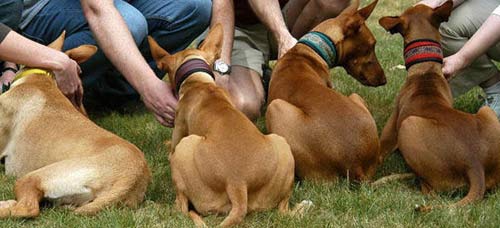AKC STANDARD
COLOR
Ranging from tan/rich tan/chestnut with white markings allowed as follows: White tip on tail strongly desired. White on chest (called "the Star"). White on toes and slim white snip on center line of face permissible. Flecking or other white undesirable, except for any solid white spot on back of neck, shoulder, or any part of the back or sides of the dog, which is a disqualification.
[hr]
DISCUSSION
The shade of the Pharaoh Hound coat may vary from a beige-tan to a rich, reddish copper or chestnut. The paler shades must not be penalized. Usually the color deepens as the dog matures, the darker coat gradually replacing the puppy coat. However, the coat very often begins to fade with the approach of middle age, with many once copper colored dogs becoming tan in their last years. This should not be faulted. Pharaoh Hounds also begin to turn gray on the face, many at an early age. This should not be faulted. Shaded coloring is not unusual. Often the deepest color will appear down the dog's back, with the hair on the neck and shoulder blades lighter in shade. This is not a fault.

[hr]
AKC STANDARD
Any solid white spot on the back of the neck, shoulder, or any part of the back or sides of the dog.
[hr]
DISCUSSION
For obvious reasons, white markings should be kept to a minimum. The small permissible "star" on the chest can become a blaze within a few generations, and, unfortunately, this has been proven to occur in Pharaoh Hounds. This drastically changes the total look of the breed and should be penalized. The white on the toes, while permissible, should not be "socks", nor should the permissible slim white snip on the center of the face become a blaze. The white "star" is not really a star shape. Therefore, a white patch on the chest or small streamers of white on the chest (and/or throat) are acceptable. While the white tip of the tail is highly desirable, more is not better, just flashier, and 3 inches of white on the tail is not merely a tip. Extra white is not more desirable. On the other hand, a lack of white tip is not incorrect. Neither of these conditions is listed as a fault, or is called undesirable. A dog should not win or lose by the marking on his tail. Flecking is a fault. Most serious, of course, is the disqualification as described in the Standard. If the integrity of the breed is to be maintained, one should adopt a conservative approach with respect to the amount of white considered permissible.

